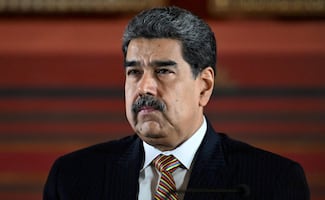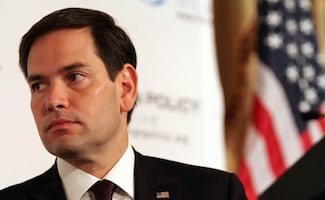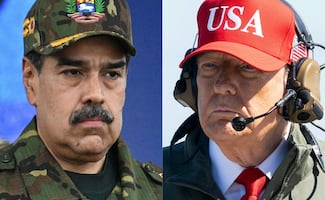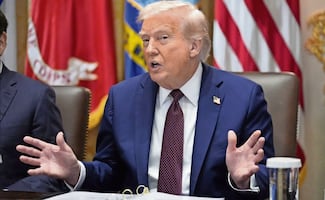Más Información

Maduro enfrenta cargos de narcotráfico y terrorismo en EU: Pam Bondi; "enfrentarán todo el rigor de la justicia"

Aeronave que traslada a Maduro a EU habría hecho una escala en Puerto Rico por "emergencia médica" del líder venezolano, reportan

Que Cuba "ponga sus barbas a remojar", dice Marco Rubio, tras captura de Maduro; "es un desastre, gobernado por hombres seniles"

New York Times califica de "ilegal e imprudente" el ataque de EU en Venezuela; alerta por repunte de violencia y "sufrimiento"

Comunidad internacional reacciona a ataques de EU a Venezuela y captura de Maduro; entre petición de explicaciones y el llamado al diálogo

Países de AL han buscado a México tras ataque de EU a Venezuela, dice Sheinbaum; hace un llamado a la unidad
Russia’s President Vladimir Putin
has just been confirmed to remain in power until 2036 by a referendum. What matters even more than the expected result, however, is the consolidation of a political model increasingly popular across the world.
After a week-long balloting, the Russian Central Electoral Commission announced on July 1 that 78% of citizens approved the amendments proposed to the 1993 Constitution that ended the Soviet system of government, including a limit of two consecutive six-year terms for the president of the Russian Federation .
The provision applies to the president at the time the legal changes enter into force, without taking into account the number of terms previously served in this position, thus paving the war for 67-year-old Putin to run again after his current term ends in 2024.
The amendments also include protecting the institution of marriage, outlaws same-sex marriage, setting children as a priority of Russia’s domestic policy, an obligation to protect national culture, and mention a belief in god as a core value.
The president will have the right to dissolve Parliament if it refuses to support the candidacy of a minister proposed by the head of state three times in a row. He will also have a greater say over the work of the Constitutional and Supreme Courts and prosecutors. In addition, the reform strengthens the role of the State Council, currently an advisory body.
Putin, who has already been in power as president or prime minister for the last 20 years, and is on course to become the longest-serving leader in modern Russian history since Josef Stalin ruled the Soviet Union , introduced the reforms in January. They quickly sailed through the Kremlin-controlled Parliament.
The Constitution is the second most long-lived Constitution in Russian history after the Soviets enacted their fundamental principles in 1936. It is a product of the dramatic 1993 constitutional crisis that brought the country to the brink of civil war between reformists led by Putin’s predecessor, Boris Yeltsin , and the nationalist and communist forces in Parliament.
Although his approval rating has declined to a record low as Russia struggles with the coronavirus pandemic, the fall of oil prices, and Western economic sanctions, Putin still maintains the support of 59% of Russians, according to the country’s largest independent pollster, Levada Centre.
Opposition leader Alexei Navalny slammed the plebiscite as a ploy designed to give Putin the right to be “president for life”. Navalny called for a boycott of the process, yet other figures from the divided opposition camp advocated voting against the constitutional changes.
As expected, the European Union and the United States criticized the process, and called to investigate the reported irregularities.
For Moscow ’s allies and friends, ranging from China’s President Xi Jinping to populist, authoritarian, and nationalist governments and political parties in Europe, Asia, Africa, and Latin America—using the Western terminology—Putin’s victory represents an alternative to liberal democracy.
Stability and order
In light of recent developments in the U.S., where the social fabric sinks into racial divisions, growing disparities, an sclerotic two-party system, and Donald Trump’s erratic behaviour, they see in Putin the embodiment of a strong and effective system.
Gone are the days when the Global South, for instance, recognized the moral authority from Western values and dogmas. In particular, since the post-World War II order, the Cold War , and the neoliberal period were used by the U.S. and its allies as a platform for their neocolonialist designs.
Instead, they are inspired by Putin’s success in the recovery of Russia, once trapped between the decadence of Yeltsin during the Clinton era of the only “indispensable nation”, and Bush’s “new world order” proclaimed in Iraq. If critics point out to the structural failings of the Russian economy, they stress the potential of the Sino-Russian alliance and the new silk road.
Putin’s achievements have been specially notorious in the global arena, restoring Moscow’s place as a superpower. First came the war in Georgia, the former Soviet republic where the Kremlin stopped the Atlantic Alliance’s forays in the Caucasus, nicknamed the “soft belly” of Russia.
In neighbouring Chechnya, Putin dealt a heavy blow to the Islamic separatists which had humiliated the Russian army, retaking the regional capital of Grozny in 2000.
While Putin was named by Forbes as the world’s most powerful man in 2013, his litmus test was the dispute for the control of Ukraine. The new pro-Western regime installed in Kiev after a “color revolution” hindered the project for the Eurasian Economic Union (EEU) launched one year later, yet the strategic Crimean peninsula in the Black Sea was annexed by Moscow.
For their part, the Russian-speaking provinces of Donetsk and Lugansk declared their loyalty to the Kremlin. Today, a low-intensity war continues in both regions, symbolizing the new bipolar confrontation.
It is no wonder that the EEU project was considered an attempt to recreate the Soviet Union by then-Secretary of State Hillary Clinton. After all, Putin defined the Soviet collapse as “the greatest geopolitical catastrophe of the century”. Therefore, Clinton said, “we are trying to figure out effective ways to slow down or prevent it.”
Moscow’s need to quell the Islamist movement in the Caucasus and Central Asia played a major role in the decision to intervene in Syria five years ago. The military action not only saved the regime of Bashar al-Assad; it also catapulted an increased Russian presence in the Middle East and the Libyan conflict, displacing Washington and Brussels.
Less well-known is the ideological force behind Putin’s policies that allowed him the consolidation of his power in parallel to the elimination of internal rivals such as the oligarchs Mikhail Khodorkovsky and Boris Berezovsky.
As early as 2013, The vineyard of the saker blog remarked that “since he got elected [2010], Putin mentioned many times the need for a re-sovereignization of Russia.” The threat of NATO bases in Ukraine, it said, “has forced him to reveal the real end goal of his agenda: the re-sovereignization of the entire planet.”
The point of no return for the Kremlin leader, it explained, was reached when the U.S. and its allies twisted the United Nations Security Council decisions regarding the Libyan crisis, in order to overthrow Muammar Gaddafi. Then the Syrian rebellion erupted; for the first time since 1945 Washington had decided to promote yet another “regime change” and was stopped by an outside power.
It added that the main goals of this strategy are the separation of the U.S. and Europe; force the U.S. to admit it does not have the might to impose “regime change” operations; encourage China and other Asian powers to stand with Russia in the defense of international law; gradually replace the dollar, and create the conditions for Latin America and Africa to break U.S. hegemony.
In the same vein, propose another civilization model, challenging “the liberal and capitalist economic order embodied in the Washington Consensus, and replace it with a model of social and international solidarity.”
According to Paul Pryce, researcher from the Latvian Institute of International Affairs, the establishment of the EEU reflected a shift in Russian identity policies towards neoclassical Eurasianism.
Pryce underscores the influence in its conception of Vladislav Surkov and Sergei Karaganov. Surkov developed the idea of “sovereign democracy,” and served as Deputy Chief of Staff in the presidential administrations of both Putin and Dmitry Medvedev from 2000 until 2011.
For his part, Karaganov is the author of the Compatriots Policy for the protection of Russian ethnic minorities in the former Soviet Union. He was a close associate of the late Yevgeny Primakov, prime minister of Russia from 1998 to 1999, and served as Presidential Advisor to both Yeltsin and Putin.
The origins of Eurasianism date from the response of Russian political elites and intellectuals to the emergence of pan-Turkism in the Ottoman Empire during the 19 century. The Eurasianists initially saw the Bolshevik Revolution as a consequence of Europeanization, yet later they adopted it as a form of national communism and a break with the West.
Following the Heartland Theory advanced by Sir Halford Mackinder, Prince Nikolai Trubetzkoi and Nikolai Berdyaev portrayed Russia as a civilization in its own right, with Russia compared to Europe or the “Atlantic civilization” as a whole, rather than to such states as France or Germany.
Nevertheless, classical Eurasianism faded away during the Stalinist era. In the earlier post-Soviet years, it was regarded as a right-wing doctrine until it was rescued by Ivan Demidov, head of the ideology section of ruling party United Russia, with the support, if not explicit, of Surkov and Karaganov.
Classical Eurasianism, concludes Pryce, was intended to hold Russia together while neoclassical Eurasianism is intended to keep the country from fragmenting, as a result of secessionist movements in its Central Asian territories “and a lack of public confidence in Western institutions.”
Editing by Sofía Danis
More by Gabriel Moyssen
Noticias según tus intereses
[Publicidad]
[Publicidad]








